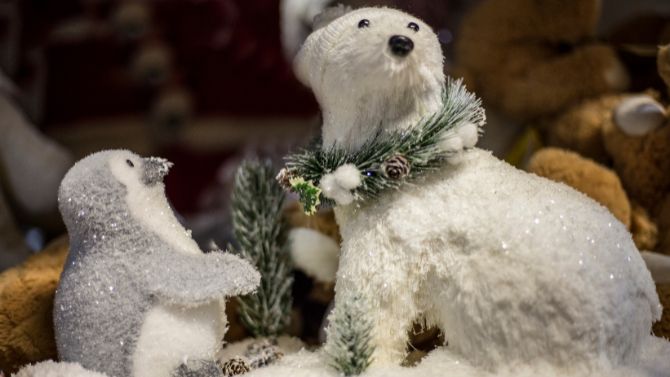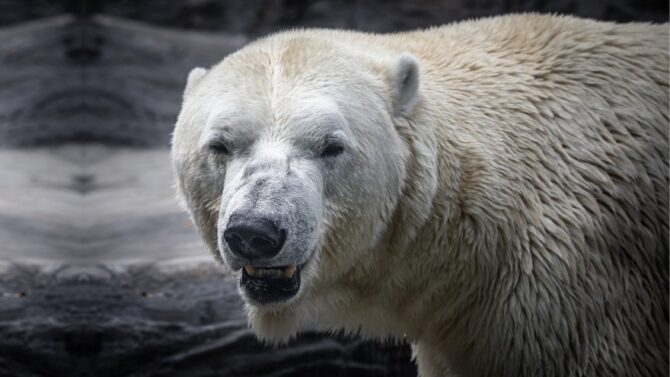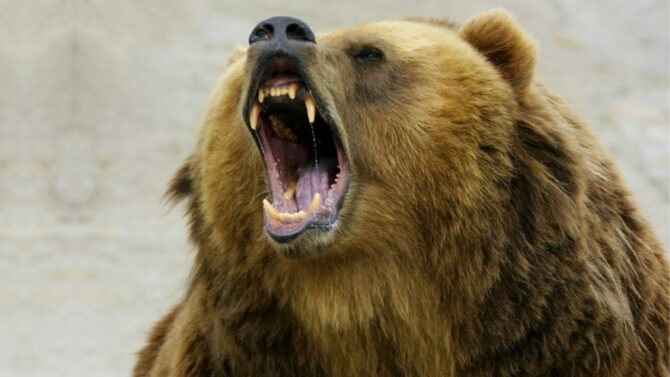If you were asking: “Can grizzly bears climb trees?” it is worth knowing that tree climbing is one of several unusual skills that bears possess.
Some reasons why a bear may climb a tree include escaping from predators, finding food, resting, and playing.
These magnificent animals are remarkable and resourceful creatures, but their size, demeanor, and power can be intimidating to people, particularly if you come across one.
Grizzly bears are very large and powerful creatures. They can climb trees but they’re slower than other bear species because of their size.
The size of a grizzly bear determines how fast or high it can climb on a tree. Although they run pretty fast, this speed doesn’t extend to climbing.
Read on to get more answers to your questions and a few important details to keep in mind if you come across a grizzly bear and decide to flee by climbing a tree.
Can Grizzly Bears Climb Trees?
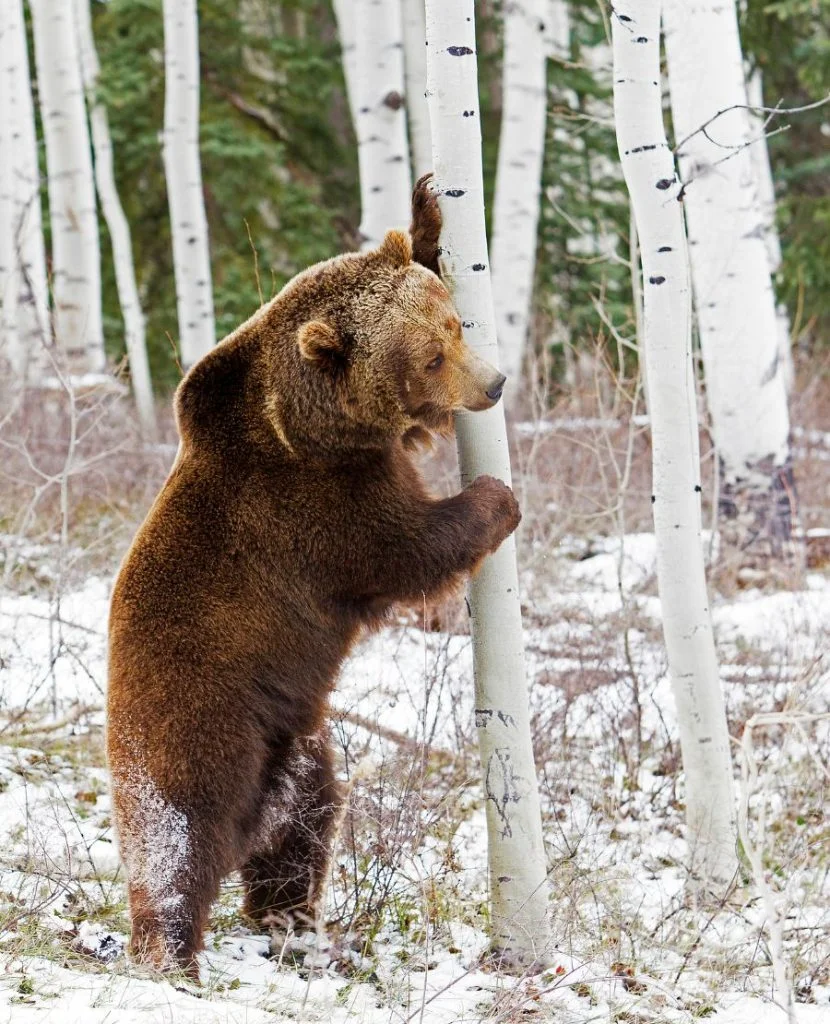
Contrary to popular belief, grizzly bears can climb trees. Grizzly cubs and adolescent subadult bears will climb trees with ease.
But, as they increase in stature and get bulkier, they gradually lose their ability to climb.
Because of their physical limitations, full-grown grizzly bears have difficulty with tree climbing.
The grizzly bear claws are larger, flatter, and finer than black bear claws, making them harder to sink into trees and mount.
Their wrist joints are fixed, and their claws bend inwards, limiting their climbing ability.
They may lack the grace and quickness of a black bear, but they compensate for it with claws, jaws, and raw physical might.
A simple study of black bears vs grizzly bears reveals four primary reasons for their poor climbing abilities:
- Grizzlies evolved in spacious settings, whereas black bears evolved in forested areas. Plains, lowlands, desolate arctic sands, and any other place devoid of trees fall within this region. Grizzly bears never needed to climb trees since their native environments did not force them to reach extraordinary heights for nourishment.
- A grizzly’s hump is a muscular tissue on their shoulder that supports their forearms, allowing them to dig extremely deep. Grizzlies’ bodies were evolved to move large loads, undertake extensive digging, and twist or pull off big things to look for food because they reside in an open area.
- The essential tool for climbing trees is usually claws. Grizzlies have somewhat curled claws and are up to four inches in length. This mixture lacks sufficient grasping qualities and is best used for digging. In contrast, black bears possess 2-inch claws that are strongly curled; this claw’s hook-like shape makes scaling trees easy.
- Size has never presented a challenge to bears when they are swimming or sprinting, but climbing up and down a tree trunk is an entirely different situation. Grizzly bears are less agile climbers since they are 2m tall and weigh around 300 to 500 kilos.
Can Baby Grizzly Bears Climb Trees?

Grizzly cubs are lively, curious animals who enjoy getting into mischief and exploring their surroundings.
Grizzly bear cubs cannot only climb trees readily during their first year of life, but they will do it frequently for amusement or to avoid harm. Cubs can climb faster than older grizzly bears.
Adult grizzly bears are just too large to climb effectively. They can climb up a tree trunk but struggle to get to the upper foliage.
Cubs, on the other hand, are nimble and lighter. They can effortlessly climb and descend tree trunks and maneuver through branches. Grizzly cubs can climb as well as black bears, if not better.
They aren’t as heavy as adult grizzlies and rely on their long, curved talons to burrow into the tree’s surface and skin, dragging themselves upward.
This helps avoid dangers and reach food supplies located up in the foliage.
Their claws have the same hard shape as black bear claws, which act as grappling hooks. This is why they are born excellent climbers.
As they grow older, however, their claws will become broader and longer, and their muscle mass will make it difficult for them to climb trees.
Can a Full-grown Grizzly Bear Climb Trees?
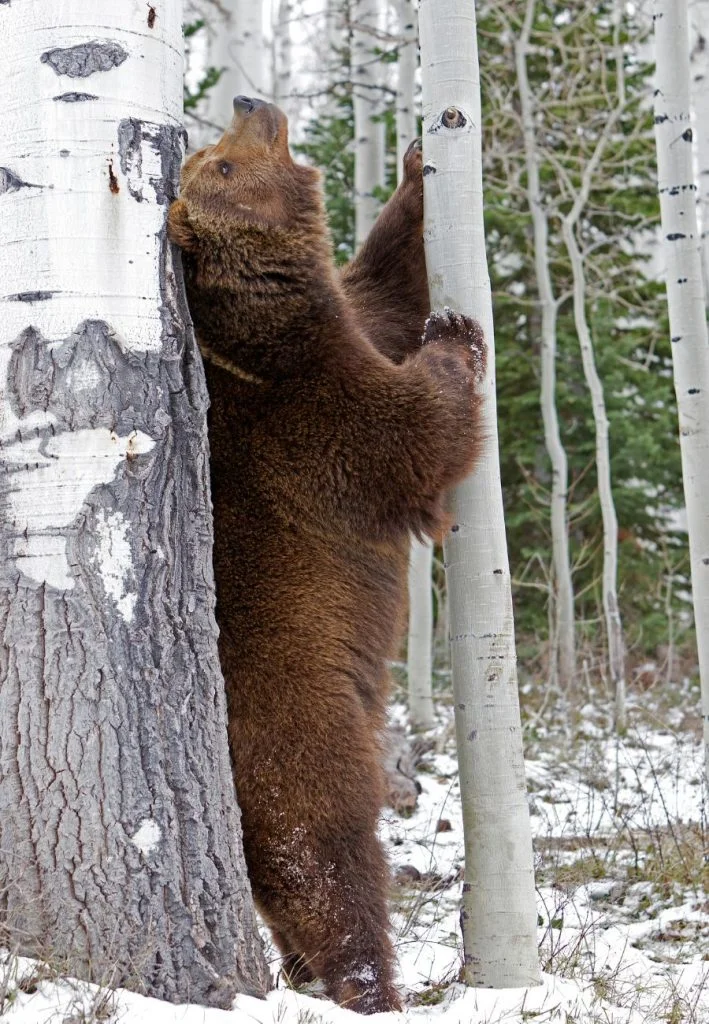
Full-grown, mature grizzly bears are not as quick as newborn cubs or black bears. But they can still climb a tree if the branches are thick and adequate for them to grasp properly.
They do, however, have an edge. Grizzlies can balance on their two limbs and reach as high as 2.8 meters in length. Therefore, they will grab the lowest twigs to utilize as platforms to climb the tree.
Do Grizzly Bears Climb Trees?
Because grizzlies were not designed for climbing, it will be uncommon to see them do so. A mature grizzly bear, on the other hand, climbs a tree for three major reasons:
To get food
Although grizzly bears are omnivores, meaning they eat both animals and plants, 90% of their nutrition comes from edible plants.
If they sniff anything they enjoy on a tree, they will climb up and obtain it, sometimes human food.
Grizzly bears are typically controlled by their hearing and smell sensory systems, which can detect flesh from up to 20 miles away.
To go after prey
Grizzly bears are the apex predators on their food chain, so they have no adversaries to flee from (apart from people and wolf packs).
As a result, they are the ideal predators, and an intense conflict between them and their victims can not end well for the opposing side.
When following prey, even humans and other bear species, grizzlies will climb a tree.
Feels threatened
Grizzlies are fiercely protective species. These lone creatures will go to any length to protect their children, food, and domain, even if it means climbing and descending a tree in a couple of moments.
Their most common purpose for climbing trees is to protect their offspring from harm.
How Do Grizzly Bears Climb Trees?
Young grizzlies will climb trees like black bears until they become too large to wriggle up, relying on their tremendous leg muscles to carry them higher, foot by foot.
Even the brute force of a grizzly bear’s legs will no longer be enough to lift it to a tree as it matures.
Grizzlies, on the other hand, aren’t foolish, so if there are lesser twigs, they’ll climb the tree one twig at a time.
How Fast Can a Grizzly Bear Climb a Tree
The grizzly bear’s climbing speed largely depends on the size of the tree’s limbs.
Grizzlies are slower and less proficient climbers than monkeys or black bears. It requires a long period for them to climb a tree.
Although grizzly bears can climb trees, they cannot move fast through them. They are far more sluggish when tree climbing than when running.
What Kinds of Trees Do Grizzlies Climb?

Because grizzlies lack hook-like claws that give a secure grasp when climbing a tree, they must rely on branches as platforms to attain new elevations.
As a result, a grizzly needs a tree with broad, sturdy branches that can sustain its weight, like canopies and whitebark pine trees.
How High Can a Grizzly Bear Climb Trees?
Grizzly bears are brown bear subspecies native to western North America.
They cannot climb small or medium-sized trees due to their usual body weight of 400 to 770 pounds (181 to 349 kg). The bear’s bulk would be too much for the tree to carry.
Adult grizzlies can reach heights of up to 8 feet (2.5 meters), and cubs can reach heights of up to 20 feet (6.1 meters). A typical grizzly bear may jump up to 20 feet (six meters) in the air.
Grizzly Bears Running vs Climbing
Even though grizzlies are large and massive, they are amazingly quick runners and are not excellent climbers, making climbing rare for these animals.
Grizzly bears can reach speeds of 30 to 35 miles per hour over short ranges. However, with a weight of up to 800 pounds, finding a sufficiently sturdy tree is the first hurdle when climbing.
These bears will be less quick and agile as they grow larger, which is why youngsters are better equipped for such feats.
Should they need to flee a dangerous situation or an angry bear, grizzly bear cubs can swiftly climb a tree.
Should You Climb a Tree if a Grizzly Bear is Chasing You?
No, you won’t be able to evade a grizzly bear by climbing a tree. They will reach you in a tree, despite being slower than other bears due to their enormous bulk and extended claws.
Avoid climbing a tree if a grizzly bear is pursuing you. Rather than mounting a tree, turn away from the bear carefully.
Make no abrupt motions, and don’t turn around and run (this will trigger their hunting instincts).
It has been observed that humans are hardly ever attacked by grizzly bears, but lay down, hide their face, and hope for a miracle when they do.
Not all bears behave the same way, so not all reactions are foreseeable.
If you ever come across a grizzly bear, one of the best pieces of advice is to avoid eye contact, which they perceive as a challenge, and to stroll rather than flee.
Because a grizzly’s top speed is 35 mph, you won’t have much time to consider if you should run, lay down, or find a tree to climb.
Grizzlies seem to be the only bear subspecies that when you encounter them, it is enough to lie on the floor on your stomach, shield your head and neck, and remain motionless.
You can attempt dropping any non-edible thing like a coat or scarf to distract the bear, or you walk away extremely slowly.
Wrap Up
Due to their stature and long claws, full-grown grizzly bears can climb trees, but they’re not particularly good at it. However, grizzly bear cubs can climb quicker than older ones.
When they want to, grizzlies can scale a tree. The level of reward has a direct impact on whether or not they do so.
While it’s great to be aware of what grizzlies can do, it’s wise not to do anything to make them want to climb a tree to get you.
They can climb trees, bring them down, claw branches in half, stride over them, and even utilize them as a cover for deception.
A mature grizzly bear might climb a tree for various reasons, although they frequently do so in pursuit of food or when their prey has retreated onto a tree.
Check out these interesting articles:

